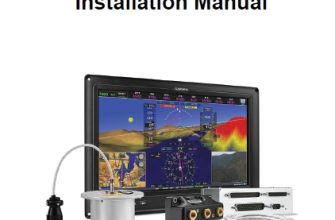Electronic Flight Instrument Part 23 AML STC Maintenance Manual Including Instructions for Continued Airworthiness
190-01112-11

This document provides Instructions for Continued Airworthiness (ICA) for the Garmin G5 Electronic Flight Instrument as installed in Part 23 aircraft under STC SA01818WI. This document satisfies the requirements for continued airworthiness as defined by 14 CFR Part 23.1529 and Appendix G. Information in this document is required to maintain the continued airworthiness of the G5.
The Garmin G5 Electronic Flight Instrument is a versatile and compact instrument designed for use in various types of aircraft. It serves as a primary or backup flight instrument, providing critical flight information to pilots. Here are some key features and information about the Garmin G5:
- Primary and Backup Display: The Garmin G5 can be used as a primary flight instrument for attitude (pitch and roll) and heading information or as a backup to traditional mechanical instruments. It’s often used to replace older, vacuum-driven attitude indicators or electrically-driven attitude indicators.
- Dual Configuration: The G5 is available in two configurations: the G5 Electronic Flight Instrument for attitude and the G5 Electronic Flight Instrument HSI (Horizontal Situation Indicator) for attitude and heading information. The HSI version also provides course deviation and VOR/LOC/GPS information.
- Bright LCD Display: It features a bright and sunlight-readable liquid crystal display (LCD) that provides clear and easily readable information, even in challenging lighting conditions.
- Integration: The G5 is designed to integrate seamlessly with various Garmin avionics and navigation systems, enhancing situational awareness and navigation capabilities.
- Autopilot Compatibility: It can be integrated with compatible autopilot systems, allowing for precise attitude and heading control when connected.
- Installation Flexibility: The Garmin G5 is compact and can be installed in a standard 3.125-inch instrument panel cutout. This makes it a cost-effective option for upgrading older aircraft with glass cockpit-like capabilities.
- Backup Power: It has its own backup battery, ensuring continued operation in case of an electrical failure in the aircraft.
- Certifications: The Garmin G5 is certified for use in a wide range of aircraft, including general aviation and light aircraft.
- Selectable Presentation Modes: Pilots can choose between different display modes, including a traditional round attitude indicator or a tape-style display, depending on their preference.
- Safety Enhancements: The G5 can display airspeed, altitude, and vertical speed tapes, adding safety enhancements beyond basic attitude and heading information.
- Traffic and Weather Display: When connected to compatible Garmin equipment, the G5 can display ADS-B traffic and weather information, further enhancing situational awareness.
- Integration with Garmin Pilot: Data from the G5 can be displayed on compatible portable devices, such as the Garmin Pilot app, for additional redundancy and convenience.
The Garmin G5 Electronic Flight Instrument is popular among general aviation pilots as it provides modern avionics capabilities in a cost-effective and compact form factor, helping to improve safety and situational awareness in the cockpit. Please note that the features and capabilities of avionics equipment may evolve over time, so it’s essential to check the latest product documentation and consult with avionics experts when considering upgrades or installations in your aircraft.





